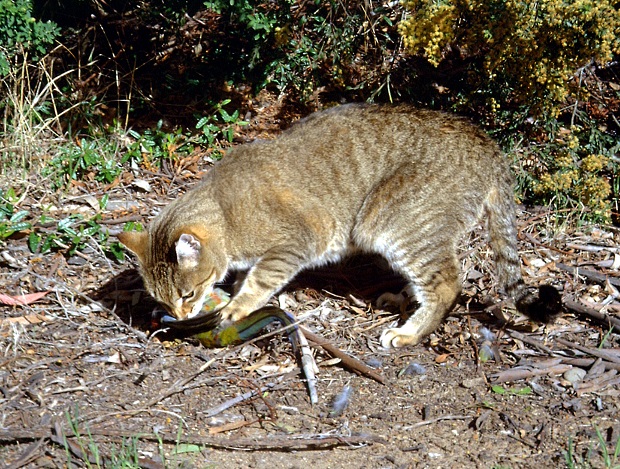Study: Cats, foxes behind Australia’s alarming extinctions

In this undated photo provided by the Australian Department of the Environment, a feral cat catches and eats a crimson rosella bird at an unknown location in Australia. Researchers have found that much of the Australian species’ decline coincided with the introduction of two animals: the feral cat, which sailors brought to Australia on ships as a means of pest control, and red foxes, brought to the continent for hunting. AP
SYDNEY, Australia — Australia has always been unique, from its geographical isolation at the bottom of the Earth to its infamous bevy of venomous creatures. Now, scientists have uncovered another unique — and disturbing — facet of Australian life: the country’s mammals are going extinct at an alarmingly high rate, due in large part to a couple of critters with voracious appetites.
A study published by the Proceedings of the National Academy of Sciences on Monday shows that more than 10 percent of the land mammal species endemic to Australia have been wiped out since European settlement. The main culprit? Cats and foxes brought to the continent by those settlers.
Australia’s extraordinary extinction rate has long been a source of puzzlement. In the rest of the world, the extinction of various species is generally blamed on humans who have overhunted the animals or destroyed their habitat. But in sparsely populated Australia, much of the vast, desert interior remains virtually untouched by people. By global standards, it should be a paradisiacal safe-haven for animals.
A group of Australian scientists set out to pinpoint the scope of the extinction problem and its cause by tracking the fate of all the country’s land and marine mammals since the first European settlers arrived in Australia in 1788.
The researchers found that 11 percent of the 273 land mammal species endemic to Australia have gone extinct since European settlement and another 21 percent are considered threatened. By comparison, just one North American native land mammal became extinct since European settlement — the sea mink, which was overhunted. Worldwide, around 1.5 percent of 5,500 mammal species are extinct.
The researchers found that much of the Australian species’ decline coincided with the introduction of two animals: the feral cat, which sailors brought to Australia on ships to keep the on-board rat populations at bay, and red foxes, brought to the continent for hunting.
As it turned out, both species hunted a little too well. And they spread rapidly.
“We knew it was bad, but I think our tallies were much worse than previously thought,” said one of the study’s authors, John Woinarski of Australia’s Charles Darwin University. “The fact that we’re losing such a large proportion of our species is a problem of international importance.”
The scientists noted that seven species that were once widespread on the Australian mainland now live naturally only on islands that the cats and foxes have yet to colonize. They also discovered that unlike the rest of the world, where larger mammals are at the highest risk of extinction, the Australian mammals being killed off are small — perfectly “meal-sized” for their predators.
Australia has a long and troubled history with introduced species. The most notorious is the cane toad, which was imported to the country’s north in 1935 in a bid to control beetles on sugarcane plantations. The trouble was, the toads couldn’t jump high enough to eat the beetles, which live on top of cane stalks.
The toads produce a highly toxic venom from glands in their skin that can kill would-be predators, and millions of them now threaten local species across the country. In the Australian study, the researches blamed the cane toad for the population decline of the northern quoll, a carnivorous marsupial that preys on the amphibians.
“You’d think Australia, with its relatively extensive area, with its relatively low population and relatively affluent society should be able to do conservation well,” Woinarski said. “But that’s not the case.”
A separate culprit the scientists identified behind the mammals’ extinction rate is the changing way the nation’s fierce wildfires are managed. In years past, indigenous Australians regularly set small fires, which burned away dry brush that is perfect tinder for wildfires. But that practice is less common today. That means wildfires tend to ignite more often and spread more widely, resulting in a loss of the mammals’ food sources and hiding places that protect them from cats and foxes.
Stuart Pimm, a Duke University biologist and global expert in present-day extinctions, said the study was both very comprehensive and very important because it finally nails down the scope of Australia’s extinction problem and the reasons behind it.
“Other than just the sheer awful news that Australia has lost so many of its species is the fact that it’s done it across areas that are very, very sparsely populated,” Pimm said. “It tells us that by being careless, particularly with invasive species, that we can do an extraordinary amount of environmental harm even in places where there aren’t a lot of people.”
Australia’s experience, he said, should serve as a warning to everyone.
“There are parts of the world where invasive species have gone amok, and that tells us we need to be very careful not to bring in any more to do any more harm,” he said.
“We need to be better stewards so that we can share these wonderful animals with our children and grandchildren.”
RELATED STORIES
Species now going extinct faster